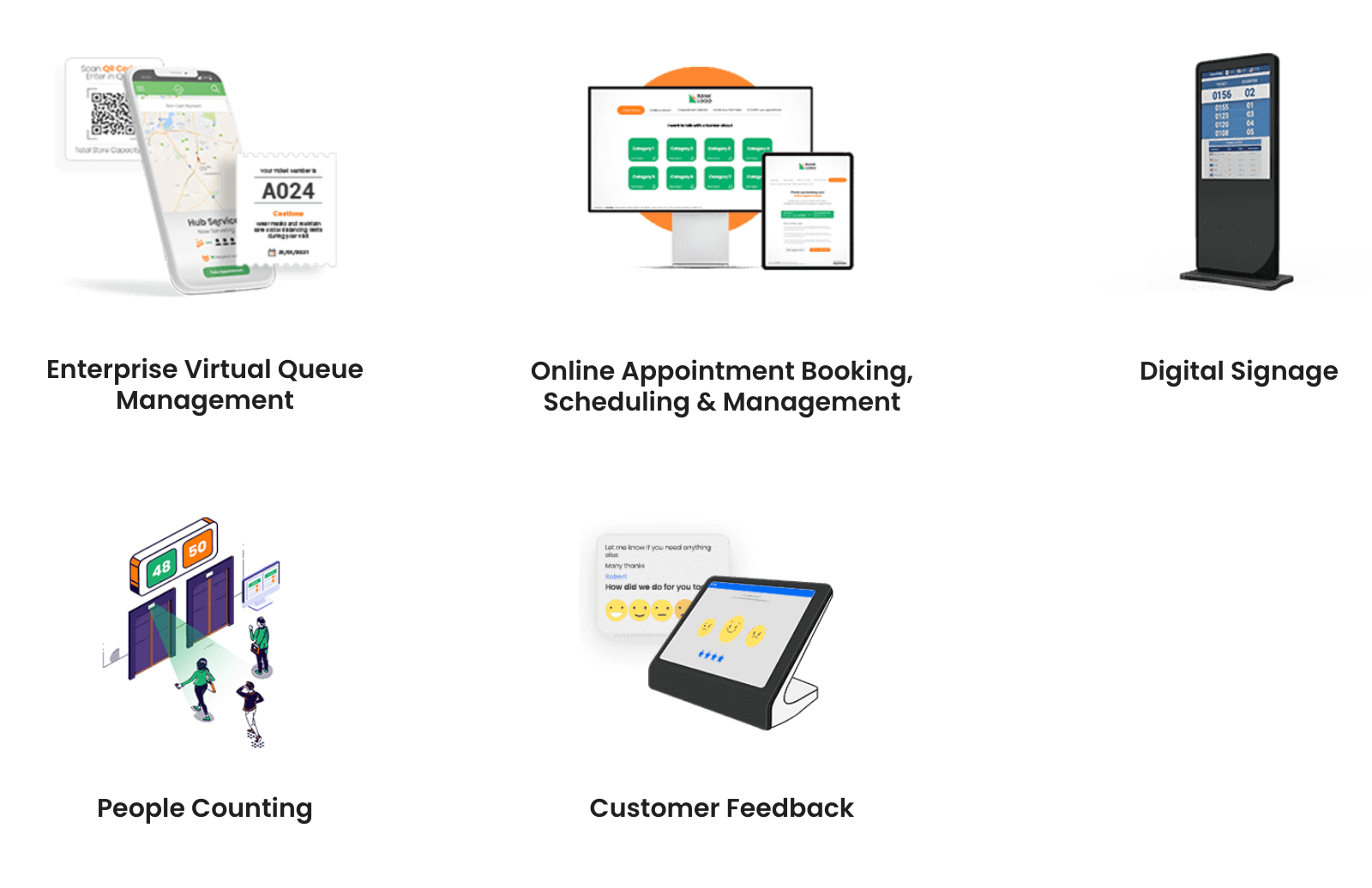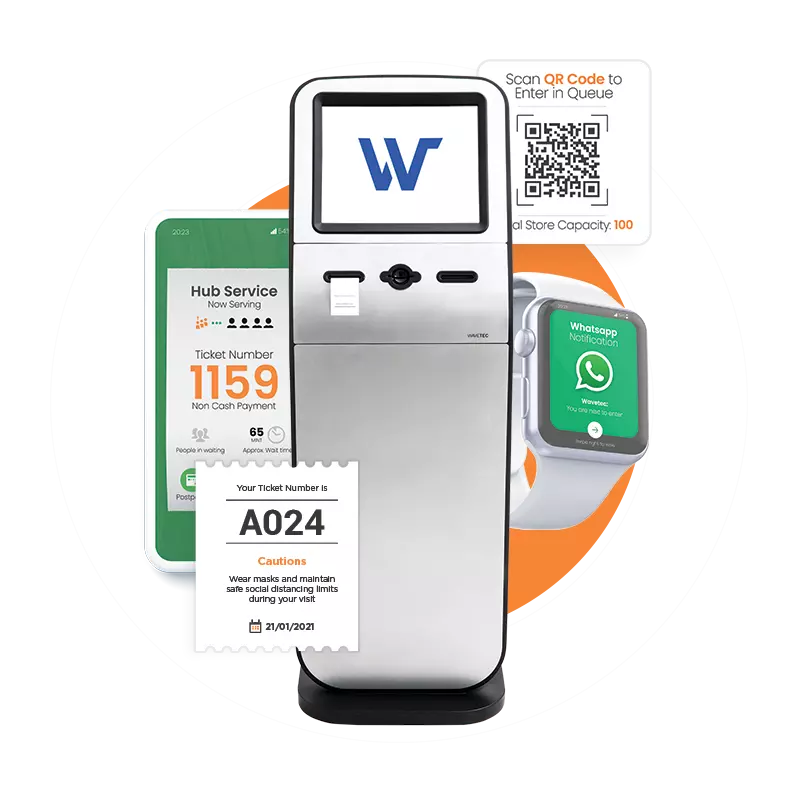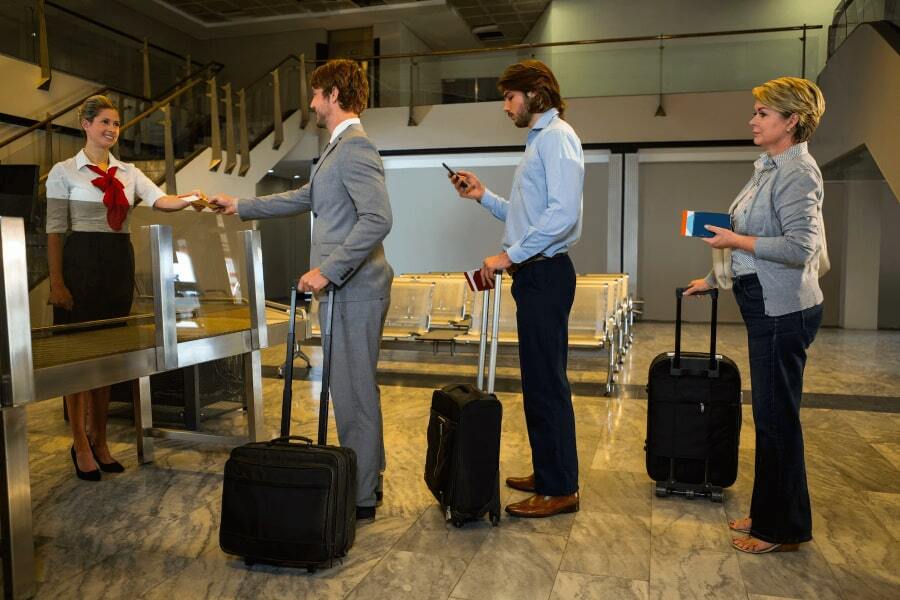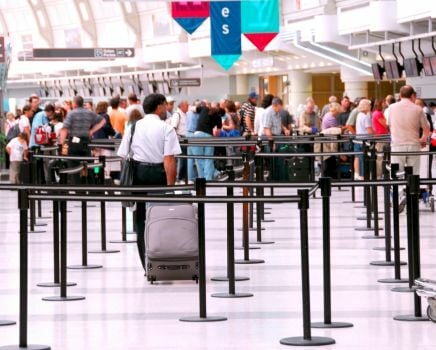Have you ever seen the chaos that comes with poor queue management at airport counters?
Managing queues properly at airports is as important as installing multiple counters. If customer flow is not optimized, it can lead to chaotic and frustrating experiences for both passengers and staff.
Long and unorganized queues resulted in excessive waiting times, causing delays at check-ins and missed flights for passengers. This adds to a passenger’s stress levels and incurs financial losses for the airline.
Enhanced passenger queuing strategies help security to take adequate measures. Without this, it would be difficult to maintain order at the airport. Inability to clear passengers for security concerns risks breaches and unauthorized access.
So, in order to keep the passenger satisfaction levels up, what should you do?
Invest in enhancing airport queue management for smooth operations. To increase airport revenue, give customers satisfaction with proper queueing, and maintain a well-functioning airport environment.
This blog focuses on how to improve queue management at the airport. We cover the top 5 strategies to manage queues and enhance customer flow at airports.
Let’s get into the details!
Statistics on Queue Management in Airports
The quality of service at the airport is correlated with passenger satisfaction levels. Here are a few statistics that highlight the importance of queue management in airports:
- The busiest airport in the United Kingdom, Heathrow Airport, reported an average estimated wait time of 20 minutes during security screening.
- According to Statista, 23% of air passengers in the UK reported that they experienced crowding at an airport while traveling. Meanwhile, 22% of travelers experienced delays and long queues at immigration.
- Another study reported that staff and queueing times are most likely to reduce the probability of a passenger promoting the airport.
5 Effective Strategies for Improving Queue Management at Airport
This part of the blog is a comprehensive guide on effective strategies for improving customer queuing at airports.
Whether you are an airport manager, a staff member, or are interested in airport operations, these strategies will provide practical queuing tips before boarding.
Here are the 5 Effective Strategies for improving queue management at airport:
- Understanding the Challenges of Queue Management
- Technology Solutions for Efficient Queue Management
- Enhancing Passenger Experience through Digital Tools
- Optimizing Airport Layout and Infrastructure
- Staff Training and Customer Service Excellence

1. Understanding the Challenges of Queue Management
Identifying the factors contributing to queue congestion
The first step in improving airport queue management is identifying the factors contributing to queue congestion. Understanding your customers and the pain points in the journey involves assessing various elements pre-arrival and at the airport.
The variables in a customer’s journey at the airport include queuing at check-in counters, security checkpoints, baggage drop-off lines, and boarding gates. Factors such as peak travel times and flight schedules add to the uncertainty in wait times.
Analyzing passenger flow patterns and bottlenecks
Understanding passenger flows and identifying bottlenecks is essential for optimizing queue management. Such patterns provide valuable insights into passenger behavior. These include entry and exit points, peak hours, and queue waiting times.
With this data, airport staff will know the areas of crowding that require more staff members. It allows the strategic allocation of resources and implements intelligent queuing systems.
For instance, the Virtual Queue Management System by Wavetec allows passengers to join queues remotely via mobile apps, reducing physical queues and enhancing the overall passenger experience.
The role of security checks and immigration processes in queues
Security checks and immigration processes are critical stages. Since these procedures determine airport security and whether passengers comply with regulations, it contributes to long airport queues.
Wavetec’s Intelligent Queue Management System integrates advanced technologies such as biometric identification, automated document verification, and self-service kiosks.
These solutions streamline security and immigration procedures, reducing wait times and enhancing the overall efficiency of queue management.
For instance, automated e-gates with facial recognition can expedite the passport control process, allowing faster and more secure passenger throughput.
2. Technology Solutions for Efficient Queue Management
Introduction to advanced technologies for queue management
Today’s fast-paced world cannot have airports with outdated technologies and manual labor for queue management. Investing in Wavetec’s airport solutions gives a wide variety of queue management solutions.
This combines digital signage, self-service kiosks, and virtual queuing to streamline the process. This technology helps airports manage queues effectively, reduce wait times, and enhance passenger experience.
Implementing automated check-in and bag-drop systems
Manually checking in and dropping bags at counters requires passengers to be physically present at a check-in counter and hand over their luggage to airport staff. This can result in missing baggage and frustration among passengers.
Wavetec offers automated check-in and bag drop solutions that significantly expedite the check-in process. Passengers can use self-service kiosks to check in with the airline and print boarding passes and luggage tags for their own bags.
This ensures no manual intervention with staff members and reduced queue lengths. These automated systems save passengers time and allow airport staff to focus on providing personalized assistance where needed.
Utilizing biometric identification for faster processing
Airports can implement biometric identification technologies to enhance security and expedite passenger processing. Biometric solutions provide secure identification using fingerprints, facial recognition, or iris scanning.
In queue management, biometrics significantly speeds up passenger verification, boarding procedures, and immigration checks. This ensures a smoother flow of passengers through the airport and reduces bottlenecks at various touchpoints.
Queue prediction and real-time monitoring using data analytics
Data analytics plays a vital role in optimizing queue management. Wavetec’s Queue Management System has sophisticated in-built algorithms and predictive analytics to forecast queue lengths, wait times, and congestion patterns.
Real-time monitoring dashboards, such as the People Counting System, provide instant visibility into queue status. Queue predictions based on historical data and real-time information proactively measure and allocates resources and deploy additional counters.
3. Enhancing Passenger Experience through Digital Tools
Mobile apps for check-in, boarding passes, and flight updates
Reaching the airport and discovering the delayed flight is frustrating for passengers. Therefore, by investing in a mobile app, airports can give travelers the convenience of handling check-in procedures and receiving real-time flight updates on smartphones.
Virtual queuing systems and self-service kiosks
Airports can implement virtual queuing systems and self-service kiosks to alleviate long queues and reduce waiting times. Enterprise Virtual Queuing Systems allows passengers to join queues digitally and receive notifications when it is their turn at the counter.
Spectra Queue Management Software enables passengers to use their time better. It offers online appointment booking, web ticketing, and SMS Tickets. Use it to collect customer feedback and real-time monitoring and reporting.
Personalized wayfinding and navigation assistance
Navigating large and complex airports can be a daunting task for passengers. If unaddressed, passengers can reach the wrong terminals or miss their flights. Airports can use wayfinding and navigation assistance solutions.
Wavetec’s Digital Signage solution and advanced GPS tracking technology offer dynamic and interactive maps, guiding passengers with step-by-step directions. Accurate assistance ensures passengers reach their desired locations stress-free.
Real-time information sharing through digital signage
Keeping passengers informed with real-time updates is crucial for a positive airport experience. Digital signage can be strategically placed throughout the airport. It can display relevant information which otherwise would require people to line up.
With signage boards, airports can deliver flight status, gate changes, baggage claim details, and security announcements timely. This helps reduce confusion and enhance their overall experience.
4. Optimizing Airport Layout and Infrastructure
Redesigning terminal layouts for smoother passenger flow
Ar airports can optimize terminal layouts by analyzing passenger traffic patterns and implementing intelligent queue management systems. After identifying areas of congestion, strategically plan terminal layouts.
For example, using insights from the QMS, airports can reconfigure check-in counters, security checkpoints, and boarding gates to ensure a seamless flow of passengers.
Allocating dedicated lanes for different types of passengers
To cater to the varying needs of passengers, airports can allocate dedicated lanes for different categories, such as families, business travelers, or passengers with special needs.
Virtual Queue Management System allows airports to create separate queues and assign passengers to specific lanes based on their requirements. This ensures an efficient experience for passengers of all ages with fewer wait times.
Increasing seating and waiting for areas with comfortable amenities
A key aspect of queue management is providing comfortable waiting areas for passengers. Airports can enhance the passenger experience by increasing seating capacity and offering amenities like charging stations, Wi-Fi connectivity, and entertainment options.
Improving accessibility for passengers with reduced mobility
Queue management should prioritize accessibility for passengers with reduced mobility. Airports can implement a Disability Assistance Solution, which allows passengers to request assistance through self-service kiosks or mobile applications.
With this system, you can ensure that prompt attention is given to passengers requiring special assistance, providing a seamless and dignified experience.
5. Staff Training and Customer Service Excellence
Training airport staff for efficient queue management techniques
Providing comprehensive training to airport staff on various queue management techniques is essential in bringing change. This includes educating them about strategies such as virtual queuing, self-service kiosks, and automated check-in systems.
Equip the staff with the necessary knowledge and skills to manage queues minimize wait times, and ensure a smooth flow of passengers. Provide training modules to help airport personnel understand and implement efficient queue management techniques.
Developing effective communication skills for staff members
Communication plays a vital role in queue management. Staff members should be trained to talk clearly and effectively with passengers with accurate information regarding wait times, boarding procedures, and any changes in flight schedules.
These tools enable staff members to communicate important updates and instructions to passengers clearly and timely. By leveraging such technology, staff members can efficiently manage queues and communicate effectively with passengers.
Empathy and customer-centric approach in handling queues
A customer-centric approach is crucial when dealing with queues at airports. Staff members should be trained to empathize with passengers and understand their needs and concerns.
Airport staff can create a positive and satisfying passenger experience, even during peak travel.
Streamlining interactions with passengers during queuing
Efficient queuing goes beyond just managing wait times. Staff members should be trained to identify opportunities for process improvement.
These can be minimizing redundant interactions, simplifying documentation procedures, and leveraging technology to expedite security screening processes.
Improve Queue Management in Airports – Case Studies
Let’s go through a few examples of real-life scenarios of airport queues and monitoring:
Delta Airlines deploys Wavetec Self-Service Queue Management Software
One of the leading airlines globally, Delta Airlines, partnered with Wavetec’s partner Visiontron for queue management.
Delta Airlines decided to deploy Ticket Dispensing Kiosks at multiple lounges. The kiosks are equipped with a complete package of Customer Calling Applications and a Notification system.
Self-service kiosks have support for a complete check-in process. Passengers can print boarding passes and select seats without staff assistance. Passengers print baggage tags, streamlining the bag-dropping process with options to accommodate international travelers.
Another solution is Queue Management Service which can offer a queue remotely through digital platforms.
This feature allows appointment scheduling for passengers to book slots in advance. Integrated clear signage displays real-time information on wait times and relevant announcements.
When customers arrive at the airport, they first interact with self-service kiosks and select the desired service. They receive a paperless ticket with queue updates on the smartphone. Passengers receive another SMS alert directing them to the relevant counter number.
Connect with your passengers before they arrive. SMS alerts and Spectra Dashboards and Reporting change how your business operates at the sharp end.
Wavetec facilitates Emirates in managing customer flow
Another leading company, Emirates Airlines, partnered with Wavetec for its expertise in queue management. It has implemented cutting-edge solutions to streamline its operations and the passenger journey.
Wavetec’s solutions enable Emirates Airlines to offer efficient check-in processes via touchscreen self-service kiosks. Passengers could perform the usual check-in procedures and print boarding passes. Besides this, the kiosks could categorize customers into priority lines.
Wavetec offers a live manager dashboard and central reporting software connected via the cloud. It shows real-time data on available staff members, active counters, and customers’ serve and wait times.
With graphical trend reports, Emirates embraced innovative queue management techniques.
This reduced waiting times, eliminated bottlenecks, and helped passengers take control of their own tasks with self-service options.
Frequently Asked Questions
What are the common challenges faced in queue management at airports?
The volume of passengers during peak travel times leads to congestion and frustration. It can result in flight delays and slow down security lines,
What are the key takeaways for improving queue management in airports?
The new technology of self-service kiosks, virtual queuing systems, and digital signage empowers passengers and automates manual tasks. Such public address systems can ensure that passengers and airport staff are well-informed.
What role do staff training and customer service play in efficient queue management?
Well-trained staff members can effectively handle queues, minimize wait times, and ensure a smooth flow of passengers. They can also provide excellent customer service,
Final words
Are you looking to give your customers an enjoyable and smooth experience at the airport?
Start by improving the customer journey by enhancing queue management solutions as the first interaction at airports. Advanced queue management services include virtual queuing, online appointments, self-service kiosks in airports, and real-time information updates.
As technology evolves, airports should look to upgrade the customer experience and lessen the staff’s burden. Value-added services that reduce the need for manual interaction create a customer-centric environment.
Queuing frustration is vital in ensuring that a passenger’s journey takes off on the right foot and leaves on a positive note
Invest in making the airport customer-friendly with advanced queuing strategies.
Contact us today!
BOOK A FREE DEMO



